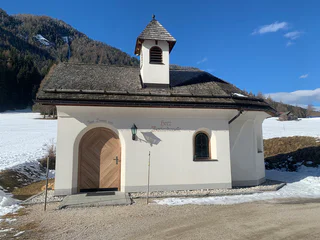
1/2
Chapel of the sacred heart of Maria
Sesto/Sexten, Sexten/Sesto, Dolomites Region 3 Zinnen
Sur les traces de notre histoire, tu te baladeras dans des châteaux et des forteresses, tu visiteras des églises et des monastères et tu découvriras, lors de visites guidées, des témoins de l'époque, des bâtiments et des places dignes d'intérêt. Inspirées par les anciens et les nouveaux maîtres, les coutumes et l'actualité, les différentes manifestations culturelles telles que les expositions, le théâtre, la danse et la musique t'invitent à échanger avec l'art et la culture.

1/2
Sesto/Sexten, Sexten/Sesto, Dolomites Region 3 Zinnen

Dobbiaco Nuova/Neutoblach, Toblach/Dobbiaco, Dolomites Region 3 Zinnen

1/2
S.Cristina Gherdëina/S.Cristina Val Gardena/S.Cristina Gherdëina/St.Christina in Gröden, S.Crestina Gherdëina/Santa Cristina Val Gardana, Dolomites Region Val Gardena

1/3
S.Cristina Gherdëina/S.Cristina Val Gardena/S.Cristina Gherdëina/St.Christina in Gröden, S.Crestina Gherdëina/Santa Cristina Val Gardana, Dolomites Region Val Gardena

Sesto/Sexten, Sexten/Sesto, Dolomites Region 3 Zinnen

Tiso/Teis, Villnöss/Funes, Dolomites Region Villnösstal

1/7
Pescosta/Pescosta, Corvara, Dolomites Region Val Gardena

1/3
San Vigilio, Al Plan/San Vigilio, Dolomites Region Kronplatz/Plan de Corones

Merano/Meran, Meran/Merano, Dolomites Region Val Gardena

Brunico città/Bruneck Stadt, Bruneck/Brunico, Dolomites Region Kronplatz/Plan de Corones

1/8
Alpe di Siusi/Seiseralm, Kastelruth/Castelrotto, Dolomites Region Seiser Alm

1/3
Piccolino/Pikolein, San Martin /San Martino, Dolomites Region Kronplatz/Plan de Corones

1/2
Dobbiaco Nuova/Neutoblach, Toblach/Dobbiaco, Dolomites Region 3 Zinnen

Siusi/Seis, Kastelruth/Castelrotto, Dolomites Region Seiser Alm

Roncadizza/Runggaditsch - Ortisei/St.Ulrich, Urtijëi/Ortisei, Dolomites Region Val Gardena

1/13
Casteldarne/Ehrenburg, Kiens/Chienes, Dolomites Region Kronplatz/Plan de Corones

1/3
Fiè/Völs, Völs am Schlern/Fiè allo Sciliar, Dolomites Region Seiser Alm

1/3
Dobbiaco Nuova/Neutoblach, Toblach/Dobbiaco, Dolomites Region 3 Zinnen

1/3
Mitterolang/Valdaora di Mezzo, Olang/Valdaora, Dolomites Region Kronplatz/Plan de Corones

Collepietra/Steinegg, Karneid/Cornedo all'Isarco, Dolomites Region Eggental

1/2
Tiso/Teis, Villnöss/Funes, Dolomites Region Villnösstal

1/5
S. Candido/Innichen, Innichen/San Candido, Dolomites Region 3 Zinnen

1/3
Siusi/Seis, Kastelruth/Castelrotto, Dolomites Region Seiser Alm

Selva/Sëlva/Wolkenstein/Sëlva, Sëlva/Selva di Val Gardena, Dolomites Region Val Gardena

1/4
Ortisei/Urtijëi/St. Ulrich/Urtijëi, Urtijëi/Ortisei, Dolomites Region Val Gardena

1/2
Dobbiaco Nuova/Neutoblach, Toblach/Dobbiaco, Dolomites Region 3 Zinnen

Rasun di Sopra/Oberrasen, Rasen-Antholz/Rasun Anterselva, Dolomites Region Kronplatz/Plan de Corones

Sesto/Sexten, Sexten/Sesto, Dolomites Region 3 Zinnen

Braies di Dentro/Innerprags, Prags/Braies, Dolomites Region 3 Zinnen

S. Pietro/St. Peter - Funes/Villnöss, Villnöss/Funes, Dolomites Region Villnösstal